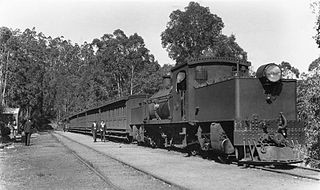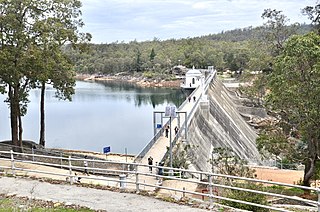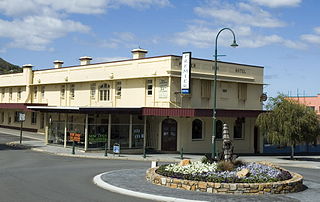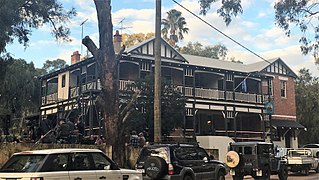
John Forrest National Park is a national park in the Darling Scarp, 24 km (15 mi) east of Perth, Western Australia. Proclaimed as a national park in November 1900, it was the first national park in Western Australia and the second in Australia after Royal National Park.

Mundaring is a suburb located 34 km east of Perth, Western Australia on the Great Eastern Highway. The suburb is located within the Shire of Mundaring.

Darlington, Western Australia, is a locality in the Shire of Mundaring on the Darling Scarp, bisected by Nyaania Creek and north of the Helena River.

The Swan View Tunnel is a former railway tunnel located on the southern side of the Jane Brook valley in the outer Perth suburb of Swan View in the John Forrest National Park on the edge of the Darling Scarp. After its closure as a railway tunnel, it reopened as part of the John Forrest Heritage Trail, a rail trail.

The Mundaring Weir Branch Railway was constructed from Mundaring, Western Australia to the site of the Mundaring Weir, and opened on 1 June 1898.

Mundaring Weir is a dam located 39 kilometres (24 mi) from Perth, Western Australia in the Darling Scarp. The dam and reservoir form the boundary between the suburbs of Reservoir and Sawyers Valley. The dam impounds the Helena River.

Swan View is an eastern suburb of Perth, Western Australia. Its local government areas are the City of Swan and the Shire of Mundaring. It is 25 kilometres (16 mi) from Perth in the Perth Hills on the edge of the Darling Scarp, just to the west of the John Forrest National Park, east of Roe Highway and north of the Great Eastern Highway.

Darlington Hall is a heritage listed building in Darlington, Western Australia.

A coffee palace was an often large and elaborate residential hotel that did not serve alcohol, most of which were built in Australia in the late 19th century.

Swan View railway station, Perth was a railway station of significance on the Eastern Railway in Western Australia. In all working timetables during the operation of this line, the station was the point of control for the Swan View Tunnel.

Mathieson Harry Jacoby was an Australian politician who twice represented the seat of Swan in the Legislative Assembly of Western Australia, from 1901 to 1905 and then again from 1908 to 1911. He was Speaker of the Legislative Assembly from 1904 to 1905. Outside politics Jacoby was a noted viticulturist, one of the pioneers of the West Australian wine industry.

The Federal Hotel is located at 23-25 William Street in Fremantle, Western Australia, opposite the Fremantle Town Hall.

The Premier Hotel is a hotel and a heritage listed building located on the corner of York Street and Grey Street, opposite the Albany Town Hall, in Albany in the Great Southern region of Western Australia.

Darling Range Hotel was a hotel in Bellevue, Western Australia, on the end of the slope on the Great Eastern Highway at the 'bottom of' Greenmount Hill and just north of the former Bellevue railway station, and over the road from the Helena Vale Racecourse.

The P&O Hotel is a heritage listed building located at 25 High Street on the corner of Mouat Street in Fremantle, Western Australia. It was one of many commercial buildings constructed in Fremantle during the gold boom period in the late nineteenth and early twentieth century.
Perth marshalling yard was a railway marshalling yard to the immediate west of Perth railway station in Perth, Western Australia and east of West Perth railway station.

The Parkerville Tavern was opened in 1902 in Parkerville a hills suburb of Perth, Western Australia. It was originally called The Railway Hotel and later The Parkerville Hotel before adopting its current name in the 1970s.

The Mount Helena Tavern was opened in 1902 in Mount Helena, a hills suburb of Perth, Western Australia. It was originally called the Lion Mill Hotel, then the Mount Helena Hotel, before acquiring its current name. Locally it is referred to as The Mounties.

Mundaring Weir Hotel, is located in Mundaring, Western Australia.

The Sawyers Valley Tavern was established in 1882 in Sawyers Valley, a hills suburb of Perth, Western Australia. It was originally called the Sawyers Valley Hotel before acquiring its current name.




















